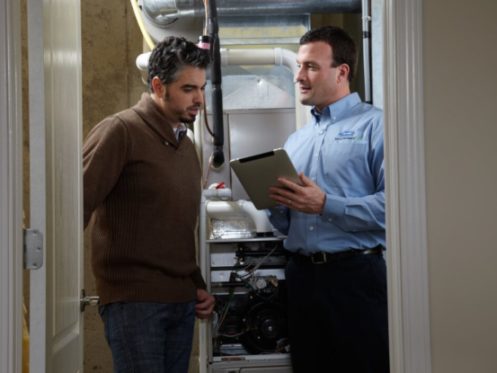The design of your plumbing system is such that it should allow water to move in one direction. Sudden pressure changes inside the pipes and fitting can cause the water to move in the wrong direction, a plumbing phenomenon known as backflow. The reversed flow of water allows potentially contaminated water to enter and contaminate the clean water supply.
From inconveniences to costly disasters, backflow poses a range of potential problems. Installing backflow devices at cross connections in your plumbing prevents contamination of your water supply. While an excellent step, concerns about backflow don’t stop there, and Summit Heating & A/C recognizes as much. It is important to regularly inspect your property’s backflow preventer device and perform thorough backflow testing. Our certified plumbers will perform the inspection and testing so you can enjoy every last one of several benefits.
1. Compliance With Regulations
Most U.S. states and municipalities have stringent regulations requiring regular backflow testing and inspection of installed backflow preventers. In Denver, the Water Quality Control Commission is in charge of regulations related to backflow testing. These regulations require that all properties in the area, residential or commercial, must have a backflow preventer installed, and the device must be tested annually. The regulations also require that any property that fails a backflow test must take care of the necessary repairs and retest within a specific timeframe.
Compliance with these clear regulations will help you avoid legal trouble. Non-compliance may attract hefty fines and penalties. You may incur additional fines and penalties if your property fails after retesting. How much these penalties would cost you is, in most cases, much higher than what you would spend to schedule backflow testing and carry out the necessary repairs and replacements.
2. Safeguarding Health
Contaminated water may contain a wide range of pathogens, including bacteria and viruses. These pathogens pose a serious health hazard and may cause infections, various illnesses, and, in extreme cases, death.
Regular backflow preventer inspection and testing ensures all measures are in place to prevent the contamination of your building’s clean water supply. Similarly, backflow incidents can affect the main water supply, spreading the health and safety risk to other properties in your neighborhood. By preserving the quality of your clean water supply, you will prevent waterborne diseases and safeguard public health.
3. Prevention of Property Damage
Installing a backflow preventer and scheduling backflow testing lowers the risk of damage to your property. Water flowing backwards into your property can accelerate corrosion in your plumbing network, which increases the risk of problems such as burst pipes. The water damage can also affect your flooring materials, walls, and furnishings and can provide the perfect environment for mold and mildew growth.
All these damages can greatly reduce the value of your property. Potential tenants and buyers will rightly want to stay away from a damaged property whose backflow prevention system doesn’t work optimally. You will be losing money every month your building remains unoccupied, and if you’re looking to sell, you can expect your property to remain on the market for a long time.
4.Compliance With Insurance Requirements
It will no doubt give you peace of mind knowing you will not be financially liable in the event of a backflow incident. Insurance companies often require commercial properties to conduct regular testing and properly maintain backflow prevention systems. As a homeowner, you may need to check if the same applies to your insurance provider.
Compliance with these requirements is critical to ensuring your insurance coverage remains valid. With valid insurance coverage for your home or commercial property, you have financial protection in the event of a backflow incident to cover you for potential damages. Depending on the type and severity of the damage, repair costs can run quite high, and it will be a great relief not to have to pay out of pocket.
5. Checking Functionality and Integrity of Backflow Preventive Device
Backflow preventers malfunction and degrade over time. These devices have rubber seals, springs, and other moving parts that wear out over time. Of course, with regular maintenance, your backflow prevention device can continue to work efficiently and last longer.
Regular inspection and testing provides an opportunity for your plumber to identify any issues with your device and ensure the preventer is working as required. If the backflow preventer fails the test, the plumber can professionally repair it or replace it as may be required.
6. Checking Plumbing System Performance
Beyond checking the integrity of the backflow preventer itself, backflow testing can identify problems with your plumbing system. For an experienced plumber with a keen eye for detail, pressure imbalances, deteriorating pipes, and similar problems will not escape our attention during the backflow testing.
Identifying these potential problems early allows for timely repairs and replacements. Such work will maintain your plumbing system’s optimal performance and reduce the chances of malfunctions and disruptions. Timely repairs and replacements can also save you money since the problems with your plumbing system may worsen over time and become more expensive to fix.
The Process of Backflow Testing Explained
Getting the job done right is key to enjoying the many benefits of backflow testing. It is a job to be left only to experienced professional as backflow testing follows distinct steps and requires specialized tools and equipment. Our certified plumbers at Summit Heating & A/C use the latest techniques and technologies and are well-versed in all the steps that comprise professional and thorough backflow testing.
The plumber will inspect the installed backflow prevention devices and your overall plumbing system. Thanks to a trained eye and experience, an expert can easily identify potential issues during this preliminary inspection.
The next step will be setting up the backflow testing equipment. The plumber will connect gauges, test kits, and other specialized equipment to your backflow prevention device. The equipment will measure flow rates and water pressures and detect any system backflow. In addition to a forward flow test, our plumber will use a simulated backflow test as part of the testing procedures. These thorough tests help to determine if your backflow prevention is working effectively to prevent water from flowing in the wrong direction.
The plumber will record the test results, namely flow rates and pressure readings. The expert will also document any abnormalities and issues observed during the inspection and testing. Documentation of these issues is excellent for future reference. Based on the inspection and testing findings, the plumber may recommend necessary maintenance and repairs to ensure the continued proper function of backflow prevention devices. When you choose a certified company to conduct the testing and implement the recommendations, you can avoid the hassle of working with different service providers to test, repair, or replace your property’s backflow prevention system.
Be Proactive and Schedule Backflow Testing Today
Backflow testing is important for residential and commercial plumbing maintenance as it protects your water supply, ensures everyone’s safety, prevents property damage, and meets regulation and insurance requirements. Contact Summit Heating & A/C to schedule backflow testing for your property. Our trained and certified plumbers will identify and accurately address any backflow issues, reducing exposure to potential health hazards and preventing legal problems while maintaining your plumbing system’s integrity.
We are Denver’s most trusted company, offering a comprehensive range of heating, cooling, plumbing, and electrical services. Turn to us for a plumbing inspection today!


